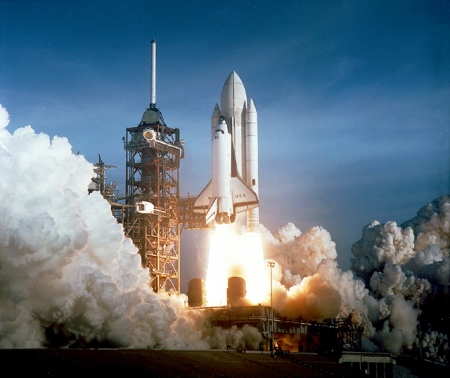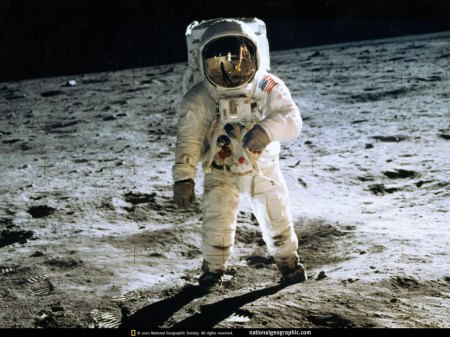
Click for Trailer
Last night I went to see “Moon“, starring Sam Rockwell. It was excellent, both as a fascinating sci-fi story and for its relatively accurate science. The premise is that, in the near future, the moon is being mined for Helium-3 to fuel fusion power plants back on Earth. Sam Bell (played by Rockwell) is an astronaut just finishing up a 3-year stint on an isolated mining base on the far side of the moon with only the robot Gerty (Kevin Spacey) to keep him company.
Things get interesting when Sam crashes his rover and wakes up back in the base, face to face with a younger version of himself. The two struggle to figure out what is going on in a race against time with a “support crew” on the way to get the base back in working order.
This movie is what more science fiction movies should be like. It is rare for this more serious, thought-provoking, and less explosion-oriented side of sci-fi to make it to the big screen (or the small one for that matter). Director Duncan Jones hits the nail on the head:
In my mind, the golden age of SF cinema was the ‘70s, early ‘80s, when films like Silent Running, Alien, Blade Runner and Outland told human stories in future environments. I’ve always wanted to make a film that felt like it could fit into that canon.
There are unquestionably less of those kind of sci-fi films these days. I don’t know why. I have a theory though: I think over the last couple of decades filmmakers have allowed themselves to become a bit embarrassed by SF’s philosophical side. It’s OK to “geek out” at the cool effects and “oooh” and “ahh” at amazing vistas, but we’re never supposed to take it too seriously. We’ve allowed ourselves to be convinced that SF should be frivolous, for teenage boys. We’re told that the old films, the Outlands and Silent Runnings, were too plaintive, too whiney.
I think that’s ridiculous. People who appreciate science fiction want the best for the world, but they understand that there is an education to be had by investigating the worst of what might happen. That’s why Blade Runner was so brilliant; it used the future to make us look at basic human qualities from a fresh perspective. Empathy. Humanity. How do you define these things? I wanted to address those questions.
Before I launch into a spoiler-laden look at the science in the film, I want to encourage you to go watch it for yourself. Unlike the vacuous effects-laden sci-fi that is so easy to watch and then forget, I find myself still mulling over “Moon”, revisiting the haunting and thought-provoking future that it portrays so simply but effectively. Unfortunately as an independent film it had a limited release, but if you can find a theater near you that is playing it, it is well worth watching. And with the 40th anniversary of the Apollo 11 moon landing coming up next week, there couldn’t be a more fitting time to revisit the Moon.
Now, how good was the science? Surprisingly good! (And I’m not the only one who thinks so!) Read on for spoilers and the few places where the science goes wrong…

The movie starts off with Sam running on a treadmill in the lunar base. This is good and bad. The good is that it is very accurate to show a lunar astronaut having to exercise quite a lot to stay in shape. Under 1/6th the Earth’s gravity, muscle and bone loss would be serious problems, so lunar workers would have to stick to a strict workout regimen to stay in shape, expecially if they had been up there for three years and were about to head back to Earth.
Unfortunately, this first scene on the treadmill makes it abundantly clear that the gravity inside the lunar base is one g. Sam is running normally, with nothing obviously holding him down to simulate Earth gravity. In fact, throughout the whole movie, they make no attempt to hide the fact that the gravity inside the base is Earth gravity. This makes sense on a purely pragmatic level: it would be very costly and complicated to film a movie with simulated low gravity, and this movie just didn’t have the budget to do that. It also doesn’t really change the story at all, so from a storytelling standpoint it is also unnecessary.
The base itself is suitably futuristic looking, although I think they made it a little bit too large and austere to be realistic. Lots of blank white wall paneling and room to walk around. I suspect real lunar bases will be quite a bit more crowded, and no wall space will be wasted. But this is really a nitpick; I think they chose the base design as a deliberate throwback to 70s sci-fi films (especially 2001 and Star Wars), and to accentuate the sterility and loneliness of Sam’s position.

I really liked that Gerty the robot was not very anthropomorphized. He is essentially several robot arms and a big clunky case hanging from the ceiling. He has a small screen that displays emoticons and a camera with a dilating pupil. Of course, as a character he was very interesting, and his limited emotional expressions added some subtle comic relief to the film.
Ok, so what about this Helium-3 business? It’s actually good science! The lunar soil is chock full of this light isotope of helium because it is constantly bobmarded by helium nuclei in the solar wind. Helium-3 is important because it is one of the easiest fuels to use to sustain nuclear fusion. Alas, the Earth doesn’t have much of it. This gives a plausible reason for a company to be mining the lunar soil: if Helium-3 can be harnessed to power the world, whoever controls the supply would get mighty rich as long as they can keep the costs of production down.
The press kit for “Moon” has more information about Helium-3 mining if you’re curious. (Yes, they actually did their homework for this movie!)
Ok, now what about the cloning? Well, my biology training consists of 9th grade, and some assorted books about evolution that I have read since, so I am less qualified to comment on this scientifically. I think it’s plausible that human cloning will occur on the same timescale as building bases on the moon. What’s less plausible is having hundreds of rows of ready-to-resuscitate adult clones in cold storage.
Also, as the movie progresses, it is clear that the older version of Sam is rapidly degrading as he reaches the end of his 3 year mission. I don’t know how plausible it is to hard-wire self destruction into a living organism. But again, it may not be that far out there. I know that a big part of modern cancer research is searching for ways to trigger the cells’ self-destruct mechanisms. Maybe that could be induced for the whole body…

The trickiest part is the implanted memories. Each clone wakes up with identical memories, presumably taken from the “original” Sam Bell many years ago. As far as I know, we have nowhere near enough understanding of how human memory works to pre-load memories like that.
I really liked the logic behind the clones though. If a company could create clones, pre-trained and ready to work, it would make a lot more sense to use them than to continually train and launch new astronauts to the base. And then once the clone is reaching the limits of human psychological endurance, just dispose of it and revive a new one. Morally shady? Yes. But then, what are giant corporations good for if not cutting moral corners to increase profits?
Another science problem that I noticed was that, at one point in the movie, Sam drives his rover away from the base to escape the signal jamming that has been preventing him from communicating with the relay satellite to Earth. Finally, he looks up into the sky to see the gibbous Earth hanging overhead. It’s a powerful image for an emotional scene, but unless his base was very close the edge of the far side of the moon, he would have had to drive a very long way to see this sight. I guess we are never told specifically where the base is, but it seemed implied that it was smack dab on the opposite side. If that’s the case, this view is not consistent with the amount of driving that Sam did. It is an accurate view of what one might see if they did drive around far enough to see the Earth though.

Finally, young Sam escapes the base by launching himself in the same container used to launch the Helium-3 capsule. Now, the problem here is that inanimate capsules can probably withstand a hell of a lot more g-forces than a human, and he didn’t even have a very good cushion to use during acceleration. It’s likely that he would have been killed by the g-forces. But then, even this isn’t too big a deal, because he admits that this is a problem in the movie. And given that he’s about to be killed by corporation goons, his choice to risk the launch and possibly survive to live for a few years on Earth makes sense.
So as you can see, most of my science qualms are nitpicks. This movie really did a great job with the science, partially because they clearly did their homework, but also because it doesn’t resort to ridiculous circumstances in lieu of plot. The plot is about the characters. It is gripping and fascinating with no need to invoke space-time warping or brain-sucking aliens or anything like that.
All in all, Moon is a great science fiction movie, with a great story and some excellent acting. And as a bonus, the science ain’t bad either. Definitely check it out if you get the chance.















